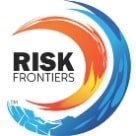Australia is one of the most fire prone country on earth, accounting for tens of thousands of individual fire ignitions on a yearly basis.
Although the vast majority of these fires occur in remote areas, where low rainfall and humidity is met with high temperatures, many are damaging to properties, infrastructures, crops, livelihood and, in some cases, are responsible for personal injury and loss of life. In fact, bushfire losses feature prominently amongst the top five natural disasters in Australia, in terms of insurance and broader economic impacts, as illustrated by data from the Insurance Council of Australia. A clear example of a devastating bushfire impact is the recent Black Summer bushfires of 2019/20 with more than $2.4 billion in insured losses recorded, and 34 deaths directly attributed to the fires.
For 30 years, Risk Frontiers has led the development of natural catastrophe models for the Asia-Pacific region. The FireAUS loss model, covering bushfire and grassfire impacts across Australia, provides a comprehensive tool for the quantification of risk at the location and portfolio level. Building on our recognised machine learning capability, peer-reviewed research and on-the-ground post-event surveys, FireAUS has national coverage at each individual Australian address. “
FireAUS Model Overview
FireAUS takes advantage of two cutting-edge technologies: MODIS satellite data and machine learning. The MODIS satellite system sees every point on Earth every 1-2 days across multiple spectral bands and at a spatial resolution of 500m. Consequently, MODIS tracks a wide array of Earth’s vital climate systems. Together with Risk Frontiers’ 120 years of fire damage data, the MODIS burnt area product provides the necessary dataset for FireAUS’ machine learning models to simulate the complex relationships between fire occurrence, propagation, weather, topography and built-environment.
Fire propagation in FireAUS is simulated using a spatio-temporal modelling approach called cellular automata (CA). The stochastic CA model relies on local evolution rules that describe the transitions between areas identified by satellite data as burned and their unburned neighbours, for each model time step. Rules are defined as a function of burning and directional spread probabilities derived from historical training datasets and the machine learning algorithm. This data-driven approach captures the complex stochastic process of fire spread dynamics and is well suited for probabilistic modelling.
FireAUS simulates stochastic fires at a spatial resolution of 1km, and estimates damage at 100m using a machine learning model trained on loss data from past fires. The 50,000 simulation years catalogue provides enough samples for a Monte-Carlo-based loss distribution at any given location.
FireAUS Features
Dynamic Fire Propagation
FireAUS explicitly rely on dynamic weather and climate variables to simulate stochastic fires.
Address Level Risk Intelligence
FireAUS resolves damage at 100m which is a high enough resolution to estimate address level bushfire and grassfire risk.
Future Climate Analysis
FireAUS can be adapted for future climate analysis providing insight into the impact of a given emission scenario, at a future point in time.
Who can utilise FireAUS?
Insurers/ReInsurers
FireAUS generates bushfire and grassfire loss model outputs at portfolio and address level. It is used for capital management and risk pricing.
Distributed Network Service Provider
FireAUS allows DNSPs to model their potential liability risk for causing a bushfire. It informs liability insurance placement.
Governments
FireAUS provides granular address level bushfire and grassfire risk metric unders current and future climate assumptions. It helps with short to medium term planning and policy making.
FireAUS Technical Specifications
Hazard Resolution |
Variable |
Exposure Resolution |
Location Address Level |
Event Catalogue |
50,000 years |
Line of Business |
Residential / Commercial / Industrial |
Business Interruption |
Residential ALE / Commercial BI / Industrial BI |
Fire Ignition and Propagation Parameters |
Location, weather/climate variables and indices, population variables including road network and railway distribution, topographic variables, environmental variables including fuel load. |
Coverage |
All Properties on mainland Australia and Tasmania. 100% GNAF |

Learn More About FireAUS
Get the opportunity to speak with the team who developed the FireAus model.
Briefing Notes
Read our latest research
Delve into the insightful articles on climate risk and resilience from the team of risk scientists at Risk Frontiers.
Hurricane Helene: The significance and destruction
Hurricane Helene: The significance and destruction Jacob Evans, Risk Frontiers Hurricane Helene was the strongest hurricane (tropical cyclone) on record to strike the Big Bend
How much longer will the Muswellbrook earthquake swarm last
How much longer will the Muswellbrook earthquake swarm last Paul Somerville The ongoing Muswellbrook earthquake swarm (Risk Frontiers, 2024, Briefing Note 503) has now continued
A Wild and Windy end to Winter 2024
A Wild and Windy end to Winter 2024 Stuart Browning During the last week of August and into early September, Southern Australia experienced a prolonged
